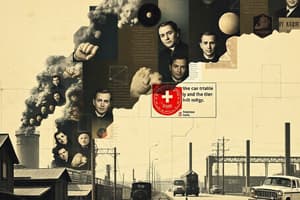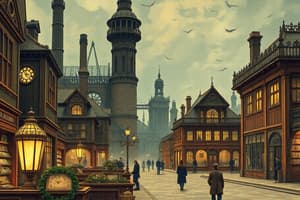Podcast
Questions and Answers
What significant shift occurred during the Industrial Revolution in the United Kingdom?
What significant shift occurred during the Industrial Revolution in the United Kingdom?
The economy shifted from agrarian and handicraft to industrial and machine-manufacturing.
How did the Industrial Revolution affect the cost and availability of goods?
How did the Industrial Revolution affect the cost and availability of goods?
It led to faster production, which reduced costs and made goods more accessible.
What was one negative consequence of the Industrial Revolution on global trade?
What was one negative consequence of the Industrial Revolution on global trade?
It contributed to wealth inequality between goods-producing and goods-consuming countries.
Name two inventions from the Industrial Revolution that were driven by electricity.
Name two inventions from the Industrial Revolution that were driven by electricity.
What role did transportation play in the Industrial Revolution?
What role did transportation play in the Industrial Revolution?
How did labor-saving machines impact production during the Industrial Revolution?
How did labor-saving machines impact production during the Industrial Revolution?
What communication advancement emerged during the Industrial Revolution?
What communication advancement emerged during the Industrial Revolution?
What broader societal changes accompanied the economic transformations of the Industrial Revolution?
What broader societal changes accompanied the economic transformations of the Industrial Revolution?
What were the typical working hours for factory workers during the time described?
What were the typical working hours for factory workers during the time described?
Why did child labor arise in the factory system?
Why did child labor arise in the factory system?
What prompted the rise of labor unions during this period?
What prompted the rise of labor unions during this period?
How did safety standards change in the first half of the 20th century?
How did safety standards change in the first half of the 20th century?
What impact did labor-saving devices have on physical activity among people?
What impact did labor-saving devices have on physical activity among people?
What are some lifestyle-related diseases that increased due to changes in physical activity and diet?
What are some lifestyle-related diseases that increased due to changes in physical activity and diet?
In what ways did indoor office work alter people's daily physical exertion?
In what ways did indoor office work alter people's daily physical exertion?
What role did processed foods play in the trends of unhealthy habits?
What role did processed foods play in the trends of unhealthy habits?
How did the Industrial Revolution contribute to advances in medicine?
How did the Industrial Revolution contribute to advances in medicine?
In what way did industrialization affect the average person's quality of life?
In what way did industrialization affect the average person's quality of life?
Explain how the rise of specialist professions was a consequence of industrialization.
Explain how the rise of specialist professions was a consequence of industrialization.
What issue arose from the overcrowding of cities during the Industrial Revolution?
What issue arose from the overcrowding of cities during the Industrial Revolution?
Identify a major environmental issue that escalated due to the Industrial Revolution.
Identify a major environmental issue that escalated due to the Industrial Revolution.
How did the Industrial Revolution impact worker safety and wages?
How did the Industrial Revolution impact worker safety and wages?
What role did improved communication play in medical advancements during the Industrial Revolution?
What role did improved communication play in medical advancements during the Industrial Revolution?
Discuss the significance of mass production for the middle class during the Industrial Revolution.
Discuss the significance of mass production for the middle class during the Industrial Revolution.
What was a social consequence of the increased specialization of workers in factories?
What was a social consequence of the increased specialization of workers in factories?
What type of housing typically emerged in cities during the rapid urbanization of the Industrial Revolution?
What type of housing typically emerged in cities during the rapid urbanization of the Industrial Revolution?
Describe how industrialization changed the relationship between individuals and land ownership.
Describe how industrialization changed the relationship between individuals and land ownership.
What governmental changes occurred as a result of the growing needs of industrial societies?
What governmental changes occurred as a result of the growing needs of industrial societies?
In what way did the Industrial Revolution exacerbate pollution problems?
In what way did the Industrial Revolution exacerbate pollution problems?
How did the Industrial Revolution affect public health in urban areas?
How did the Industrial Revolution affect public health in urban areas?
What role did factory owners play in the safety conditions of workers?
What role did factory owners play in the safety conditions of workers?
Flashcards
Factory Workers' Wages
Factory Workers' Wages
Factory workers earned greater wages than agricultural workers.
Working Conditions
Working Conditions
Factory workers labored long hours with poor and unsafe conditions.
Gender Wage Gap
Gender Wage Gap
Men's wages were typically more than twice that of women's in factories.
Child Labor
Child Labor
Signup and view all the flashcards
Labor Unions
Labor Unions
Signup and view all the flashcards
Reduction of Work Hours
Reduction of Work Hours
Signup and view all the flashcards
Sedentary Lifestyle
Sedentary Lifestyle
Signup and view all the flashcards
Lifestyle Diseases
Lifestyle Diseases
Signup and view all the flashcards
Industrial Revolution
Industrial Revolution
Signup and view all the flashcards
Medical Advances
Medical Advances
Signup and view all the flashcards
Mass Production
Mass Production
Signup and view all the flashcards
Middle Class Growth
Middle Class Growth
Signup and view all the flashcards
Specialization of Labor
Specialization of Labor
Signup and view all the flashcards
Urbanization
Urbanization
Signup and view all the flashcards
Housing Shortages
Housing Shortages
Signup and view all the flashcards
Pollution
Pollution
Signup and view all the flashcards
Infectious Diseases
Infectious Diseases
Signup and view all the flashcards
Natural Resource Depletion
Natural Resource Depletion
Signup and view all the flashcards
Environmental Degradation
Environmental Degradation
Signup and view all the flashcards
Urban Planning
Urban Planning
Signup and view all the flashcards
Health Laws
Health Laws
Signup and view all the flashcards
Economic Power Shift
Economic Power Shift
Signup and view all the flashcards
Worker Safety
Worker Safety
Signup and view all the flashcards
Economic Transformation
Economic Transformation
Signup and view all the flashcards
Supply and Demand
Supply and Demand
Signup and view all the flashcards
Wealth Inequality
Wealth Inequality
Signup and view all the flashcards
Transportation Advances
Transportation Advances
Signup and view all the flashcards
Labor-saving Machines
Labor-saving Machines
Signup and view all the flashcards
Telegraph
Telegraph
Signup and view all the flashcards
New Tools Development
New Tools Development
Signup and view all the flashcards
Study Notes
Industrial Revolution: Benefits and Shortcomings
-
Causes of Industrial Revolution: Agrarian and handicraft economies shifted to industrial and machine-manufacturing economies, beginning in the UK during the 18th century and spreading globally. This dramatic economic transformation influenced human interactions and the relationship between humanity and the planet.
-
Positive Impacts:
- Increased production and reduced costs: Factories and machinery produced goods faster and cheaper than hand-made items, resulting in declining consumer prices for widely used items like shoes, clothing, and household goods. Increased supply spurred the rise of foreign markets and trade balances favorable to manufacturers, boosting wealth for companies and governments through tax revenues.
- Enhanced transportation and communication: Advancements in road, rail transportation, and the telegraph, and later telephone and fiber optics, facilitated the rapid sharing of information across industries (manufacturing, agriculture, energy, medicine). Labor-saving inventions like the spinning jenny (driven by electricity and fossil fuels like automobiles) dramatically increased efficiency.
- Medical advancements: Industrialization allowed for faster production of medical instruments (scalpels, microscopes, test tubes) and their distribution to physicians, improving healthcare quality. Improved communication between medical professionals led to quicker sharing of treatments.
- Increased wealth and better quality of life: Mass production lowered costs of necessities for common people, enabling savings and personal wealth building. Industrialization created new employment opportunities outside of farming, diminishing the importance of land ownership as a primary source of wealth. This led to better wages and opportunities for the middle class to emerge, taking more economic power away from the aristocracy, resulting in updated laws to accommodate the industrialized society.
- Rise of specialized professions: Industrialization attracted people from rural areas to cities for factory jobs, requiring the division of labor into specialized roles. This development led to specialization and expansion in professions like teachers, trainers, builders, physicians, lawyers, and other support positions. Cities and towns rapidly expanded.
-
Negative Impacts:
- Urban overcrowding and unsanitary conditions: Cities and industrial towns struggled to accommodate the influx of people, leading to crowded, unsanitary housing (shantytowns), sewage issues, and contaminated drinking water, creating ideal conditions for infectious diseases (typhus, cholera, smallpox, tuberculosis). Improved medical solutions and public health measures resulted from these conditions.
- Pollution and environmental degradation: Industrialization significantly negatively impacted the environment by depleting natural resources (water, forests, minerals). This led to, and exacerbated, widespread water and air pollution, biodiversity loss, habitat destruction, and global warming. The burning of fossil fuels, for example, increased atmospheric carbon dioxide, greatly contributing to climate change. The world's human population and pursuit of industrial wealth accelerated these issues.
- Poor working conditions: Production prioritized profit over worker safety and wages, with long hours (14-16 per day, 6 days a week) and low pay (women and children earning significantly less than men). This spurred labor unions (beginning as a reaction to child labor) for better working conditions. Laws were developed to protect workers and limit child labor, shorten the workday, and establish safety standards.
- Rise in unhealthy habits: The availability of labor-saving devices (tractors for farms, automobiles, etc) decreased physical activity levels in the population. Sedentary lifestyles, combined with processed foods high in salt and sugar, increased the occurrence of lifestyle-related diseases (heart disease, diabetes, cancer).
Studying That Suits You
Use AI to generate personalized quizzes and flashcards to suit your learning preferences.





